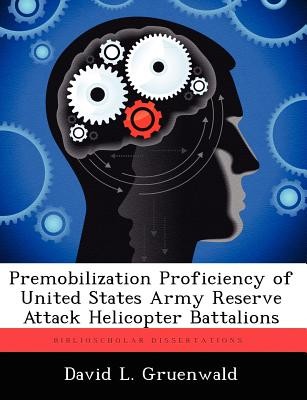
- We will send in 10–14 business days.
- Author: David L Gruenwald
- Publisher: BiblioScholar
- ISBN-10: 1249284740
- ISBN-13: 9781249284741
- Format: 18.9 x 24.6 x 0.5 cm, softcover
- Language: English
- SAVE -10% with code: EXTRA
Premobilization Proficiency of United States Army Reserve Attack Helicopter Battalions (e-book) (used book) | bookbook.eu
Reviews
Description
Attack helicopter battalions are combat maneuver units that conduct supporting attacks which aid, protect, and compliment other maneuver forces by destroying massed enemy mechanized forces and other enemy forces with aerial firepower, mobility, and shock effect. They are employed as a battalion in order to provide the commander with this highly mobile and lethal destruction capability. The fundamentals of attack helicopter operations do not change by component. Reserve Component attack helicopter battalions are expected to perform attack helicopter operations to the same level of proficiency or standard as the Active Component. Currently, there is conflicting guidance published by Forces Command as to what level of proficiency aviation units in the Reserve component should train to in premobilization in order to prepare for their wartime mission. This study examines the ability of United States Army Reserve (USAR) attack helicopter units to maintain proficiency at the battalion level in a premobilization environment. It focuses on the resources available to Reserve units and the training requirements placed on a unit. It concludes with an analysis of a USAR attack helicopter unit's ability to execute all training requirements in the time available to them each training year. It offers recommendations on possible alternative training strategies and provides suggestions for further research.
EXTRA 10 % discount with code: EXTRA
The promotion ends in 18d.22:29:14
The discount code is valid when purchasing from 10 €. Discounts do not stack.
- Author: David L Gruenwald
- Publisher: BiblioScholar
- ISBN-10: 1249284740
- ISBN-13: 9781249284741
- Format: 18.9 x 24.6 x 0.5 cm, softcover
- Language: English English
Attack helicopter battalions are combat maneuver units that conduct supporting attacks which aid, protect, and compliment other maneuver forces by destroying massed enemy mechanized forces and other enemy forces with aerial firepower, mobility, and shock effect. They are employed as a battalion in order to provide the commander with this highly mobile and lethal destruction capability. The fundamentals of attack helicopter operations do not change by component. Reserve Component attack helicopter battalions are expected to perform attack helicopter operations to the same level of proficiency or standard as the Active Component. Currently, there is conflicting guidance published by Forces Command as to what level of proficiency aviation units in the Reserve component should train to in premobilization in order to prepare for their wartime mission. This study examines the ability of United States Army Reserve (USAR) attack helicopter units to maintain proficiency at the battalion level in a premobilization environment. It focuses on the resources available to Reserve units and the training requirements placed on a unit. It concludes with an analysis of a USAR attack helicopter unit's ability to execute all training requirements in the time available to them each training year. It offers recommendations on possible alternative training strategies and provides suggestions for further research.


Reviews